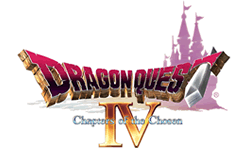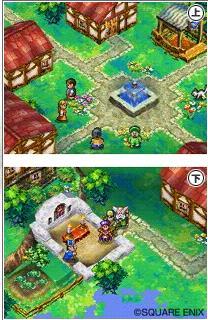|
|

|
PLATFORM
|
DS
|
BATTLE SYSTEM
|

|
INTERACTION
|

|
ORIGINALITY
|

|
STORY
|

|
MUSIC & SOUND
|

|
VISUALS
|

|
CHALLENGE
|
Easy
|
COMPLETION TIME
|
20-40 Hours
|
|
OVERALL

|
+ Fun and unique story telling
+ Easy listening music
- A little behind the times
- Battles are repetitive at times
|
Click here for scoring definitions
|
|
|
After many years of pining, Dragon Quest fans can rejoice: Dragon Quest's Zenithian trilogy is coming to the Nintendo DS. First on the list is Dragon Quest IV: Chapters of the Chosen. Previously released on the original NES, DQIV's subsequent remakes have continuously passed over the U.S. time and time again. Finally, Square-Enix has seen fit to remake it once more, and this time the States were not left out. So, did the remade Zenithian trilogy kick off with a good start and leave the rest of the games to be highly anticipated? Or does it fail, leaving the next two installments nothing to be desired?
Dragon quest IV: Chapters of the Chosen's story is broken up into five chapters, each with its own protagonist. Unique to the RPG genre, the game begins with a short introduction to the main character, and swiftly leaves him to ponder his purpose in life as the rest of the cast is introduced. The first is Ragnar McRyan, noble soldier of King and Country who embarks on a quest to find out why the children of the land are disappearing. The next chapter features Tsarevna Alena who, along with her two faithful consorts, enters into a contest of strength to prove she is no pushover princess. The aspiring merchant Torneko in the following chapter yearns to become the greatest and richest merchant in the land. Meena and Maya, chapter 4's twin heroines, give up their professions as fortune teller and dancer respectively to avenge the murder of their father. Chapter five rounds up the story, as the main hero/heroine's town is destroyed by the forces of Psaro the Manslayer, he/she must travel the world and join forces with the chosen one's to vanquish an ancient evil before it destroys all of mankind. The story is a simple one; most if it is left up to the player to figure out by conversing with the various NPCs in towns, cities, castles, etc. The main characters do little talking, so there is a very small amount of character development. You only figure out their purpose by talking to people. That being said, make sure to talk to everyone you meet, otherwise you might miss out on a lot. This makes for a story that is as shallow or deep as you like it. Either you explore the world blind, or you soak in the words of everyone you find while unraveling the story little by little. Classic Dragon Quest. It is the kind of story that gave the Dragon Quest series its fame. There is a kind of charm in these games that fans love and definitely won't be missing in this title.
The battle system is turn-base, and is no different than any other Dragon Quest game. The only the players portraits and stats are shown on the bottom portion of the screen with the enemies lined up in a row on the top portion of the screen. Commands are selected, and the turn is carried out. Only four out of the eight characters can be used at a time. However, if you are fighting on the world map, or any where else that allows you to have your party wagon handy, you can swap characters in and out during battle. This can help during difficult fights. You can swap out dead people. Also, each character has their own unique traits, and for certain battles it can be fun trying to figure out which party formation is the best and testing your theory. The placement of each characters matter as well because the character in the first position will be targeted by the enemy more often that characters in the fourth position. The bottom line, though, is that the battle system is way behind the times and may get a little boring. Those looking for a new way to play Dragon Quest won't find it here. However, It is still largely without fault and won't detract from the overall experience.
 The use of both screens allow the player to see much more.
The use of both screens allow the player to see much more.
|
|
As stated before, the game was originally released for the NES. Now, it is one of the many RPGs to add to the DS's library. This is no simple port, though. The game has been completely remade in order to fit the DS nice and snug. However, the interface is still about 15 to 20 years old. The menu screen isn't like what RPG players might be used to today. Items will need to be constantly juggled around between your party members, and they can only use an item if it is in their individual, limited inventory. Extra spoils may be placed in a separate inventory inaccessible during combat. Further, the equipment screen might be a little hard to find at first as it is under a different sub menu, and not on the "top" menu like we're all used to. Those are small obstacles, though, and nothing to detract from enjoying the game. You can save your game at any town with a church. And if you can't find one there is a handy quick-save option that surprisingly doesn't automatically erase when loaded again, letting you permanently save wherever you want. One thing that's change for the better is full control of your party members during battle. In the original DQIV, only the hero/heroine's commands be selected during battle. Your party member's actions were chosen by the computer. Perhaps this was an attempt to add some sense of realism by promoting the idea that you are in control of yourself (the Hero character) and the other characters are just traveling along with you and act on there own. There is little strategy in this, though. So thankfully, this is a nice new addition to the DS version's gameplay.
Veteran composer Koichi Sugiyama crafted the music for DQIV, just as he did for just about every game in the DQ series. It is a great score that sounds very similar to other Dragon Quest titles. One interesting detail is that the game has about 5 different overworld themes. Whereas most RPG's will have one, each chapter has a different song to listen to while strolling around between settlements and caves. Nothing too special, but the music is quite good, nonetheless.
Being a game that has been released a few times before, one can't say that it is extremely original. After all, many players have experienced what Dragon Quest IV has had to offer. But as previously stated, this is not just a port, it has been completely overhauled. New content (an additional chapter for example) and a zesty localization make this game worth playing. And it should get credit for the fact that the original version on the NES was probably the first to take such liberties with the story. In fact, not very many games have a story structure quite like it. One thing that has been added is a new side quest that allows you to create your own city. Once you meet a particular NPC, he will tell you that he wants to start his own town, but will need your help to find people around the world who want to give up their current life and start over somewhere new. Throughout the course of chapter 5, Hoffman (the aforementioned NPC) will tell you people he has heard about that want to start a new life. You go out and find that person, and watch your town grow. It's not much, but it's a little something extra.
 Both screens during a battle.
Both screens during a battle.
|
|
Probably the biggest change the you will see in the game is, well, what you see. The visuals are really well done. Much more color and life has been added to this version. One of the bonuses is that in each town and many of the dungeon you can rotate the camera a full 360 degrees. Akira Toriyama's character designs look good on the DS. Both of the DS's screens are used. When traveling the outside, the top screen is used for the world map. When in a town, the top screen provides extra viewing of the location making it easier to see where you might need to go next. This is especially helpful in some dungeons.
The game is pretty short, only taking about 30 max. It is also not very challenging if you take care not to run away from random encounters too frequently. There are some bosses that seem like a little too big of a jump in difficulty, but not a huge hinderance. Once the game is completed, you can start a 6th additional chapter where you can recruit a new playable character and beat the game again for a slightly altered (and a littler happier) ending.
Despite the many good things about this game, the one major drawback is that it is way behind the times. RPGamer veterans will find nothing new but better graphics and an easier interface. However, this is a perfect chance to relive an old classic. And for those who have never played the game before, It is a chance to experience something that paved the way for many RPGs that came after it.
Review Archives
|









